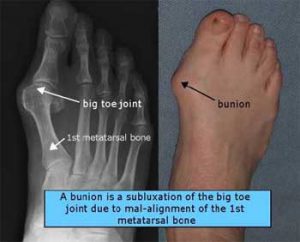
Conservative methods of treating bunions include wearing wider shoes and perhaps foot soaks to decrease the soreness associated with an acute problem.
However, considering the fact that bunions are a bony structural problem, the most effective treatment is a surgical one.
Hallux Valgus (Bunions): a (sometimes painful) bump at the medial base of the great toe. Excessive pronation and hypermobility of first metatarsal ray causes toe-off to come off the medial (inside) side instead of the plantar surface of the great toe. This force stretches and distorts the joint.
A bunion is a bone deformity involving the first metatarsophalangeal joint, or the joint attached to the great toe. Less commonly, a tailor’s bunion or bunionette involves the fifth metatarsophalangeal joint, or the joint next to the baby or fifth toe. The problem may involve one or both feet, but commonly one foot is more painful than the other.
Bunions are progressive throughout life. Certain factors, such as the type of shoe, amount of activity, surface of ambulation, and heredity may affect the type and rate of development of bunions. Bunion pain can be present from early teen years through any age. Commonly bunions will be visibly present for many years before they become painful.
A change of shoes, activity, or body weight can cause previously non-painful bunions to become painful.
Simplistically, a bunion is present when there is an enlargement of the “bump” just behind the great toe, and the great toe become rotated or deviated and presses against the adjacent second toe. In more advanced bunion cases, the great toe can overlap or underlap the adjacent second toe. Pain is present due to the rubbing of the enlarged bunion against the inner side of a shoe. There is also pain, when the great toe presses painful against the second toe. The second toe can become a hammertoe due to the presence of a bunion. The important issue is that a bunion is a bone problem, and not a problem of skin or a cyst.
In more progressive or severe bunions, there may also be the presence of arthritis within the bunion joint or the first metatarsophalangeal joint. When arthritis is present within the joint, both the arthritis and the bunion deformity must be individually addressed and treated. Typically when arthritis is present within the bunion joint, the joint becomes stiff and the pain is sensed as being deeper and more aching in character.
Although orthotic devices do not cure bunions, in some cases they can be utilized to slow the progression of the bunion and perhaps make the foot more comfortable while wearing certain types of shoes. Orthotics are more effective for treating bunions in men than in women, mostly due to the size and styles of shoes that women usually wear.
The exact cause of bunions is unclear. Some of the causative factors include heredity, flat foot structure, ligamentous instability or laxity, muscular imbalance within the foot and birth defects. Improper shoes during childhood may contribute to the formation of bunions, but this not common. Inappropriate shoes during adolescence and early adulthood may aggravate an existing bunion formation, but shoes generally do not cause bunions to develop.


